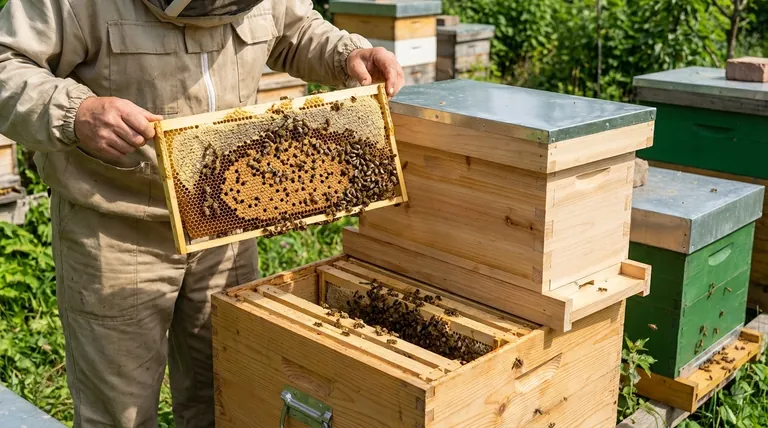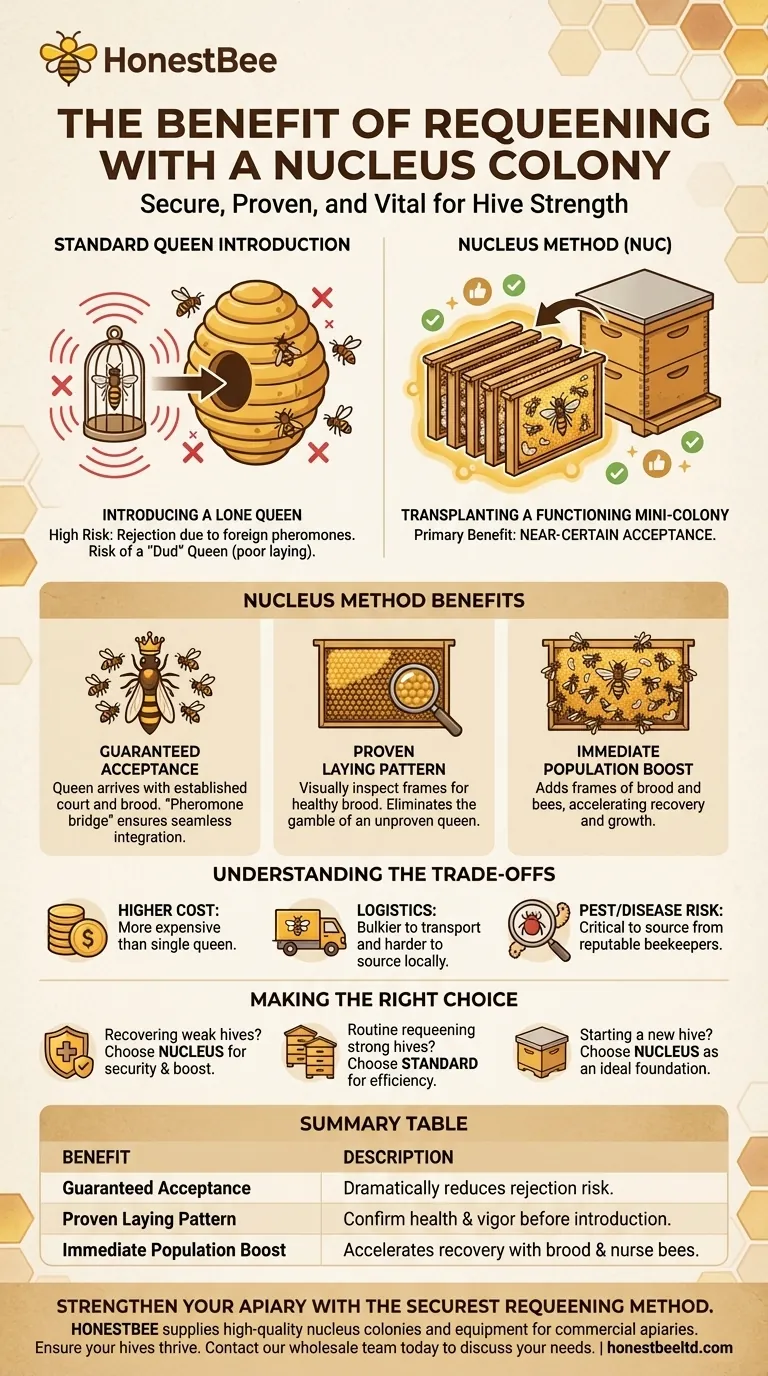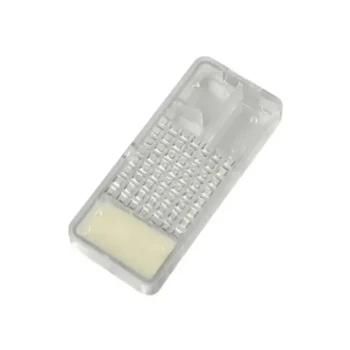The primary benefit of requeening with a nucleus colony is the near-certain acceptance of the new queen. Unlike introducing a lone queen in a cage, this method transplants the queen along with her own established court of attendant bees and brood, which dramatically reduces the risk of rejection by the host colony.
Requeening a hive is a high-stakes procedure where failure is costly. Using a nucleus colony is not just about introducing a new queen; it's about transplanting a proven, functioning mini-colony to guarantee a seamless transition and bolster the hive's strength.

The Challenge of Standard Queen Introduction
To understand the value of the nucleus method, we must first recognize the inherent risks of introducing a solo queen in a cage. A honey bee colony is a complex superorganism that is fiercely protective of its genetic lineage.
The Pheromone Barrier
A colony is unified by the unique pheromone profile of its queen. A new, caged queen has a foreign scent, which the hive's workers immediately identify as a threat.
Successful introduction relies on the workers slowly acclimating to her scent through the screen of the cage over several days before they accept her as their own. This process can easily fail if the colony is particularly defensive, stressed, or still has loyalty to a prior queen.
The Risk of a "Dud" Queen
When you buy a single mated queen, you are trusting she is healthy and well-mated. Occasionally, queens can be damaged in transit or may be poorly mated, resulting in a poor laying pattern or the production of only drone brood.
Discovering this failure only happens after the introduction process, costing you weeks of precious time and colony resources.
The Nucleus Method: A Full-Package Solution
Using a nucleus colony, or "nuc," bypasses the most common points of failure. It is less of an introduction and more of a strategic merge.
Benefit 1: Guaranteed Acceptance
The new queen arrives surrounded by her own offspring and attendant bees. She is already accepted and protected by this loyal cohort.
When you place the nuc frames into the queenless hive, her familiar pheromones and the scent of her bees and brood permeate the hive, creating a "pheromone bridge" that pacifies the host colony and ensures a smooth, peaceful integration.
Benefit 2: A Proven Laying Pattern
A nucleus colony provides undeniable proof of the queen's quality. You can visually inspect the frames before introducing them.
You will see frames containing a compact, healthy brood pattern—a clear sign of a vigorous and well-mated queen. This eliminates the gamble associated with introducing an unproven solo queen.
Benefit 3: An Immediate Population Boost
A nuc doesn't just bring a queen; it brings resources. You are adding several frames of capped brood ready to hatch, larvae needing to be fed, and a contingent of nurse bees.
This infusion of population and work provides an immediate boost to a struggling or queenless colony, accelerating its recovery and growth.
Understanding the Trade-offs
While the nucleus method is superior for security, it is not without its considerations. Objectivity requires acknowledging the downsides.
The Cost Factor
A nucleus colony is significantly more expensive than a single caged queen. You are paying for the queen, several frames of drawn comb, the brood, the population of bees, and the labor involved in raising the nuc.
Availability and Logistics
Finding a high-quality, local nuc can be more challenging than ordering a queen through the mail. They are bulkier and more complex to transport.
Risk of Pest and Disease Transmission
Because you are introducing frames and bees, there is a higher risk of introducing pests like Varroa mites or diseases such as Foulbrood. It is absolutely critical to source your nucleus colony from a highly reputable beekeeper with a proven track record of disease management.
Making the Right Choice for Your Goal
Your requeening strategy should align with your specific situation and tolerance for risk.
- If your primary focus is recovering a weak hive or ensuring success at all costs: The nucleus method is the superior choice, providing security and a vital population boost.
- If your primary focus is routine requeening in strong, healthy hives: The standard caged-queen method is more economical and efficient, especially for experienced beekeepers managing many colonies.
- If your primary focus is starting a new hive or making a split: A nucleus colony is the ideal foundation, providing a complete and balanced starter colony.
Choosing the right method is a strategic decision that directly impacts the health and productivity of your colonies.
Summary Table:
| Benefit | Description |
|---|---|
| Guaranteed Acceptance | The queen arrives with her own bees, dramatically reducing rejection risk. |
| Proven Laying Pattern | Inspect frames to confirm the queen's health and vigor before introduction. |
| Immediate Population Boost | Adds frames of capped brood and nurse bees to accelerate colony recovery. |
| Risk of Standard Method | Introduces a solo queen, which can be rejected or be a poor layer. |
Strengthen your apiary with the securest requeening method. HONESTBEE supplies high-quality nucleus colonies and beekeeping equipment to commercial apiaries and distributors. Ensure your hives thrive with our proven solutions. Contact our wholesale team today to discuss your needs.
Visual Guide

Related Products
- 5 Frame Wooden Nuc Box for Beekeeping
- Twin Queen Styrofoam Honey Bee Nucs Mating and Breeding Box
- Automatic Heat Preservation 6 Frame Pro Nuc Box for Honey Bee Queen Mating
- Professional Queen Bee Introduction and Transport Cage
- Plastic Transporting Bee Packages and Nuc Boxes for Beekeeping
People Also Ask
- What is the advantage of overwintering a nucleus? A Strategic Asset for Beekeeping Success
- What is a common feature of many 5-frame nuc boxes? The Integrated Feeder for Efficient Colony Growth
- What frames should be moved into the queenless hive when requeening with a nuc? Ensure a Successful Queen Introduction
- What are the benefits of using nucs for beginning beekeepers? Ensure a Successful First Hive with a Head Start
- What is the most common type of standard nuc? The 5-Frame Nuc Explained



















